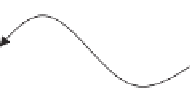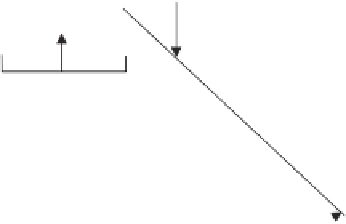Environmental Engineering Reference
In-Depth Information
as large as those computed when no correction is applied.
Third, the analysis of a series of oedometer test results
measured on desiccated highly plastic clay in a semiarid
environment showed swelling pressures that were unrealisti-
cally low when the correction for sampling disturbance was
not applied. The average results from 34 constant-volume
oedometer tests on Regina clay are shown in Figure 14.20.
The deposit is of preglacial lacustrine origin with natural
water contents near the plastic limit of 25% (Fredlund et al.,
1980a). The average liquid limit is 75%. There is no evi-
dence of a regional groundwater table in the deposit. The soil
is very stiff and is known to have high swelling potentials.
The uncorrected swelling pressures are only slightly higher
than the average overburden pressure. The oedometer results
uncorrected for sampling disturbance would suggest that the
soil is low-swelling clay. However, swelling problems are
common with a total heave on the order of 5-15 cm. Sam-
ples from depths deeper than 5.5m often show uncorrected
swelling pressures less than the overburden pressure when
using the constant volume test procedure. In other words,
the correction for sampling disturbance is imperative when
interpretating the laboratory oedometer results.
Figure 14.21 shows a comparison of corrected and uncor-
rected swelling pressure data from two soil deposits. The
results indicate that it is possible for the corrected swelling
pressures to be more than 300% larger than the uncorrected
swelling pressures.
14.4.10 Comparative Swelling Pressure Studies Using
Various Surcharge Pressures
The laboratory measurement of swelling pressure has been
the focus of several research studies. Gilchrist (1963) pre-
pared compacted samples of Regina clay at various
initial water contents and densities. Table 14.3 lists the
compaction water contents and initial void ratios used for
six series of swelling tests. In addition to measuring the
swelling pressures using the constant-volume and free-swell
testing procedures, tests were also performed by allowing
swelling from various applied surcharge loads. The ranges
of measured swelling pressures are shown in Table 14.3.
Swelling pressures were determined as the load required
to return the soil sample to the original void ratio. Correc-
tions were applied for the compressibility of the oedometer
apparatus.
Figure 14.22 shows the swelling pressure measurements
and compression curves when the soil was compacted at
22% water content to a dry unit weight of 16
.
0kN/m
3
.The
measured swelling pressures ranged from 1570 to 2160 kPa.
In general, the free-swell test performed with a low token
applied pressure resulted in the highest measured swell pres-
sures. Swelling under increased surcharge loads reduced the
measured swelling pressures.
The soil unit weight was decreased and the as-
compacted water content was increased for each succeeding
series of tests. The measured swelling pressures decreased in
1.00
P
′
s
0.96
Depth range:
0.75
3.0
5.3 m
0.92
Regina clay
Liquid limit = 75%
Depth range = 0.75 m - 5.3 m
No. of oedometer test = 34
Parallel
0.88
0.84
Rebound curve swelling
index,
C
s
= 0.065
Uncorrected swelling
pressure,
P
s
= 73.7 kPa
Corrected swelling
pressure,
P
′
s
= 134 kPa
0.80
0.78
10
100
1000
log (
σ
v
-
u
w
) (kPa)
Figure 14.20
Average compression data from oedometer test on Regina clay showing need for
applying correction to measured swelling pressure.



















Search WWH ::

Custom Search